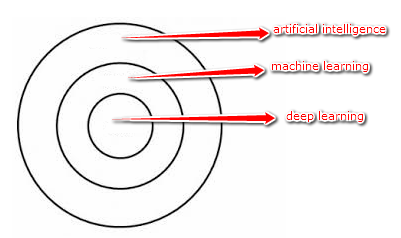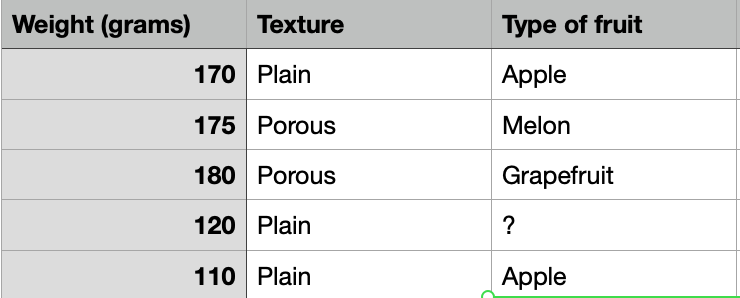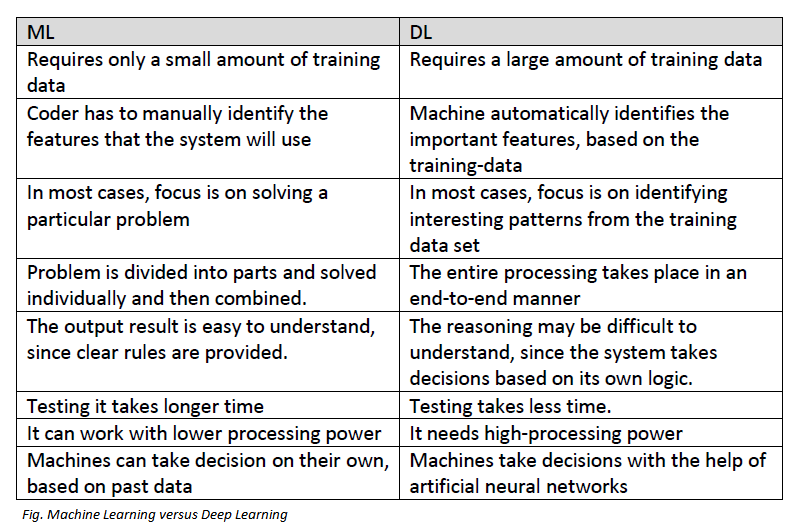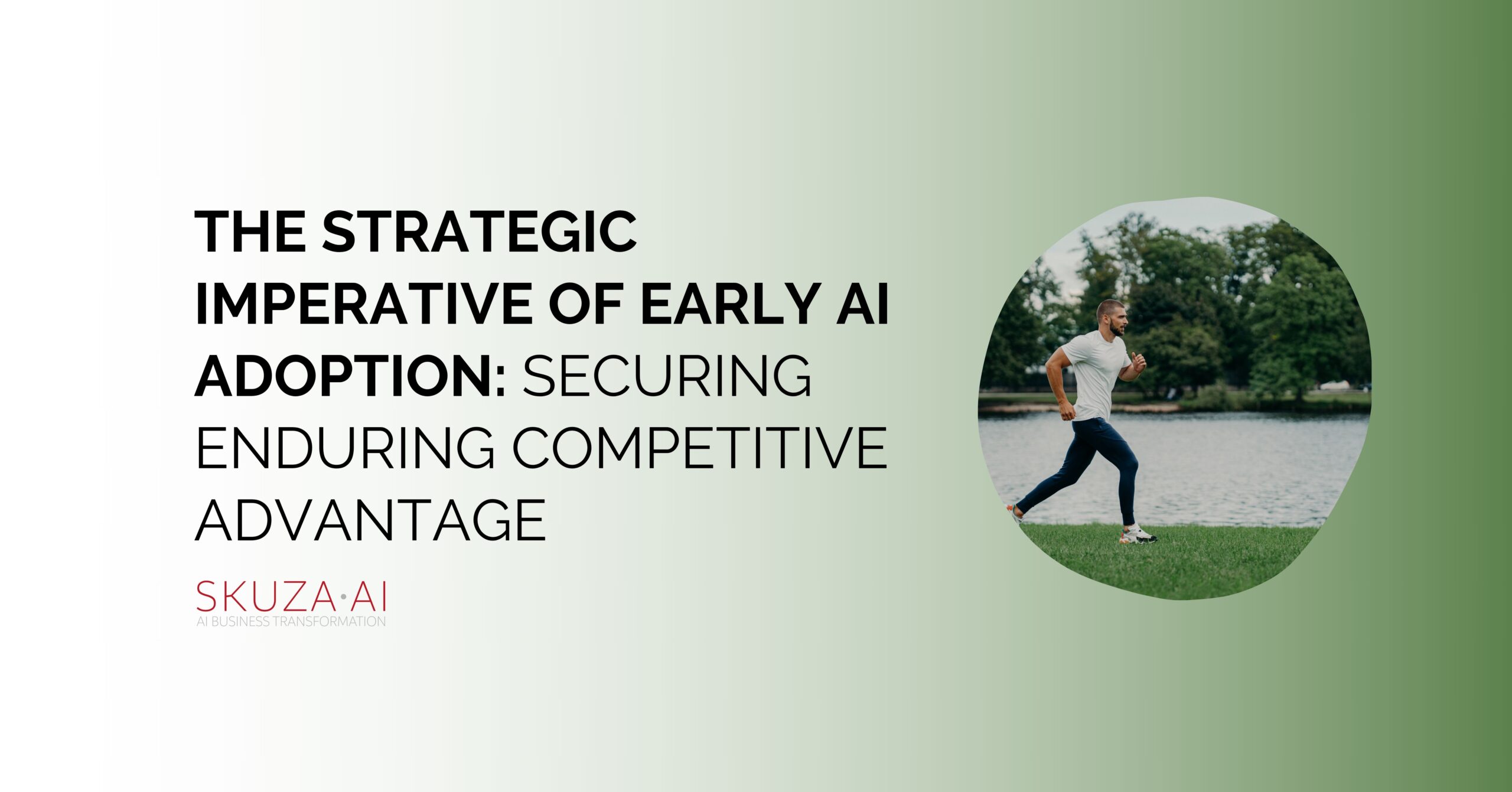Although the three terminologies are typically used interchangeably, they no longer pretty refer to similar things. Let’s look into the three buckets of computer science and compare artificial intelligence vs. machine learning with a little deep learning grasp.
Therefore, is there a distinction between artificial intelligence vs. machine learning and deep learning?
Here is a figure that tries to visualize the relationship between them and how they relate to each other:

Figure 1: Artificial intelligence vs. machine learning and deep learning
As you can see above three concentric circles, deep learning is a subset of machine learning, which is additionally a subset of artificial intelligence.
So, artificial intelligence is the all-encompassing idea that at the beginning erupted, then observed with machine learning aid that thrived later, and ultimately deep learning that is promising to boost artificial intelligence advances to some other level.
Let’s dig deeper so that you can recognize which is higher for your particular use case: AI, ML, or DL.
What is artificial intelligence (AI)?
As the title suggests, artificial intelligence can be loosely interpreted to mean incorporating the human brain into machines. Artificial intelligence is a constellation of several different technologies that enable machines with human-like intelligence levels to feel, understand, act, and learn. For this reason, everyone’s definition of artificial intelligence is different: AI isn’t just one thing.
Making things a little bit more complicated, I need to mention that AI can be divided into two groups.
Narrow AI
Most of what we use in our day-to-day lives is narrow AI, which conducts a single task or a collection of related jobs.
Here are a few examples:
- Digital assistants like Siri which can order pizza or coffee
- Software that examines data to optimize a given business process, for instance, churn management systems which try to manipulate price so the customer will not move to competitor optimize
Such systems are robust, but the field of play is narrow: they tend to concentrate on driving performance. However, narrow artificial intelligence has immense transformational power with the right application, and it continues to change how we work and live.
Subscribe to my AI Newsletter if you want to take AI bit by bit every week (link)
General AI
An Artificial General Intelligence (AGI) would be the intelligence of a machine capable of understanding the world and any human being, and with the same potential to learn how to perform a massive range of tasks with extremely high efficiency. AGI doesn’t exist and has featured in science-fiction stories for more than a century, but researchers and companies claim it is possible to build one soon.
GOF AI
Artificial intelligence is the broader thinking that consists of the whole thing from Good Old-Fashioned AI (GOFAI) to futuristic applied sciences such as deep learning. Do you remember deep blue compute capable of playing chess? It was not artificial intelligence and machine learning, neither reinforcement learning. It was a brute force search approach/science. It was Good Old Fashioned artificial intelligence (ai).
What is machine (computer) learning (ML)?
Machine learning (ML) intends to allow machines to research utilizing the furnished records and make correct predictions. The learning part is essential here. Machine learning is a subset of ai; it’s genuinely a method for completing AI.
Machine learning entails giving data to the algorithm and permitting it to research more remarkable about the processed information. It’s a learning process conducted by the algorithm. Give no data, and ML will find it hard to act.
Imagine a store with ai and machine learning-powered scanners that identify the kind of fruit, based on its attributes:

However, the closing row offers the weight and texture solely, and there is no data about a kind of fruit. By the way, data scientists are critical here, as they design the table structure. Wrong structure can mislead business operations. ML will not go beyond that, so the boundaries in which the algorithm operates should always be valuable for business profits.
AI and machine learning can be seasoned to “guess” whether the fruit is an orange or an apple. It’s the learning from the data part and decision-making job. Programming conducted by the software engineer team, scientists can now unveil the most critical part – deciding.
After the algorithm is fed with the data, it will examine the different traits between an orange and an apple. The algorithm can automatically learn, but that would be just an algorithm. Machine learning is different. It can make decisions.
Machine learning-powered systems (a subset of ai), which learn from data, will be able to fill up thousands of rows (executing millions of tasks) with a blink of the eye speed. It’s is the most exciting part of the science – automation, possible thanks to pattern recognition and computer science.
AI and ML systems can provide prompt responses, which means the difference between fruits can be grasped very quickly. The more tasks are performed, the more knowledge is accumulated by artificial intelligence, machine learning techniques.
For this reason, big data is critical for ai and ml technologies. The machine learning algorithm can learn very fast, and the data pile size doesn’t matter. Regarding our example, the more fruits are scanned by the scanner, the better the computer program’s decision-making process will be.
It is crucial to have smart data scientists and intelligent programming in place to fix the puzzle. By smart, I mean people who understand the importance of the business purpose of AI systems.
Artificial intelligence and machine learning algorithms classification
Machine learning algorithms are cataloged into:
- supervised learning (the training data is tagged with the answers, information is well labeled)
- unsupervised learning (any labels that may exist are not available for the algorithm).
Supervised learning is divided into
- classification (predicting non-numeric results, for example, a program can estimate the probability of shutting down the bank account by a customer and moving to the competitor)
- regression (predicting numeric answers, such as the range of price change due to weather conditions).
Unsupervised learning into:
– clustering (finding data clusters of comparable objects, such as a pool of customers buying specific products daily, customers complaining about the same feature, customers clusters buying similar items),
– affiliation (finding frequent sequences of objects, let’s say the app can learn that you usually take UBER and stop for a Starbucks on the way)
– dimensionality discount (prognostication, characteristic collection, and function extraction)
Applications of Machine Learning (ML)
I think this is the right moment to mention that human intelligence relates to adaptive learning and experience. It does not always depend on pre-fed data like the ones required for ML. In my opinion, artificial intelligence and machine learning will always co-exist with humans. Human intelligence is capable of inventing fantastic hardware and software, which then form a computer system or complex systems. If you look at the following examples from this perspective, it becomes evident that ai machine learning supports human behavior, letting us increase efficiency and productivity.
Data derived from image recognition
A well-known and typical example of machine learning in the real world is image recognition. Data science through data scientist hands can help a lot here.
Image recognition examples from the real-world:
- Label an x-ray as being or not cancerous. Data analysis conducted by AI machine learning can help physicians, researchers, scientists quickly identify whether the particular x-ray contains cancerous changes. Not even mention that the same can be done by extracting images from the video. If the doctor conducts an endoscopy and records the video, a machine learning-powered program can shred the video into a set of images and mark objects (make the decision). Image is a medium that drives signals, and data science likes it.
- Assign a name to a pictured face – if you own the smartphone, you are able to catalog your family pictures. Machine learning can recognize the face of a particular person and “make” it searchable. Computer science is impressive, isn’t it?
- Handwriting recognition on a tablet. Are you a Russian speaking and writing person, or maybe you can write in Russian, Polish and English? Machine learning can understand your writing style, and natural language processing (NLP) will be able to extract relevant data and translate them into characters. Superintelligence? No, it is just the ability to consume a lot of data (millions of handwriting examples) and learn the recognition part, which leads to decisions.
Machine learning is often commonly used inside an image for facial recognition. The system will recognize commonalities and match them to faces utilizing a database of individuals.
Speech recognition
Machine learning ai can be a word-for-text translation. A computer program can transform speech (another great medium of data) and voice captured live into text files. Intensities on time-frequency bands may also segment the voice.
Examples of ai powered understanding of speech:
- Search for sounds (for instance, recorded sound of a bird can help to recognize the species)
- Hardware control – “Tesla, pick me up from home,” and the car starts approaching the location.
Applications such as Google Home or Amazon Alexa are among the widespread applications of ai type of recognition. This is not the only reason why data science has become so popular.
Healthcare
Machine learning can help to diagnose diseases. Many doctors use speech-recognition chatbots to identify patterns in symptoms or image recognition to find COVID.
Examples of real-world medical diagnostics and problems approach:
- Assisting in the preparation of a diagnosis or suggesting a treatment plan.
- Analysis of body fluids to recognize the disease.
- In rare diseases, the combined use of facial recognition software and machine learning helps identify patient body scans and recognize phenotypes linked to rare genetic disorders.
Predictive analytics
Machine learning may divide the available data into groups. Afterward, analysts will measure the likelihood of a fault when the classification is complete.
Examples of predictive analysis:
- Predicting whether a transaction is fraudulent. AI technologies can recognize tone, voice, and sentiment and flag the telephone mandates as fraudulent.
- Developing prediction systems to quantify the probability of error, for instance, how many shipments will end up in the wrong location
Extraction
From unstructured data, machine learning can extract structured information. Organizations collect vast amounts of consumer data. ML algorithms automate the process of explaining datasets for predictive analytics tools.
Application examples:
- Developing strategies for preventing, diagnosing, and treating disorders.
- Collecting marathon runners’ data and finding patterns which then can be used in training facilities.
These procedures are usually repetitive, but machine learning can decode a vast amount of data and check for patterns, which then science or business can use for specific improvements.
What is deep learning (DL)?
As in the past mentioned, deep learning knowledge is a subset of machine learning; it’s undoubtedly an approach for realizing machine learning. In different words, deep learning is the subsequent evolution of machine learning.
Deep learning algorithms are roughly stimulated through the patterns discovered in the human brain. Like we use our brains to find patterns and classify several sorts of information, deep learning algorithms can be taught to accomplish identical duties.
Our brain stores unstructured data and still approach vast problems. Artificial neural networks (ANNs) are algorithms that intend to imitate the way our brains make decisions.
Deep learning can routinely find out the points to be used for classification. Machine learning requires these facets to be described manually.
Differences it’s great to know

Source: John White, MSys Training
- Automated Driving – Automotive data science teams use deep learning knowledge to notice objects such as end signs, traffic lights, animals, etc.
- Neural network in aerospace and defense – Deep learning is used to become aware of satellites’ objects that detect areas of interest (for instance, lakes, forests, animals).
- Medical Research – Cancer researchers, use deep learning-powered computer systems to discover cancer cells automatically. At the University of California, Los Angeles, data science teams constructed a special microscope that yields a high-dimensional statistics set to train a deep learning software to discover most cancers cells accurately.
- Industrial Automation – DL assists in watching employee safety around heavy equipment. The software can routinely detect when human beings or objects are inside a hazardous distance of machines. Combined with machine learning, it can write a summary of spots that should be avoided by humans.
- Electronics – Deep Learning is used in listening and speech translation. For example, the ai system helps gadgets reply to your voice and be aware of your preferences. Neural networks can recognize dialects and adjust the recognition speed, accuracy without being explicitly programmed.
Conclusion
As you can see, there is a significant difference and crystal clear relationship between AI and computer algorithms.
One of the most common answers ai and ml, and neural networks world is “it depends.” When should we use a neural network? It depends. When is the reinforcement learning algorithm suitable? It depends. Artificial intelligence and machine learning offer a massive variety of benefits, but strategists need to recognize which approach serves business best with the help of science. Machines, networks, and data science create a compelling combination, which needs to serve business eventually.
Understanding the difference between ai and machine learning and deep learning helps to make better decisions. Each pool of algorithms drives different results and demands different types, sizes, and quality of data input.

